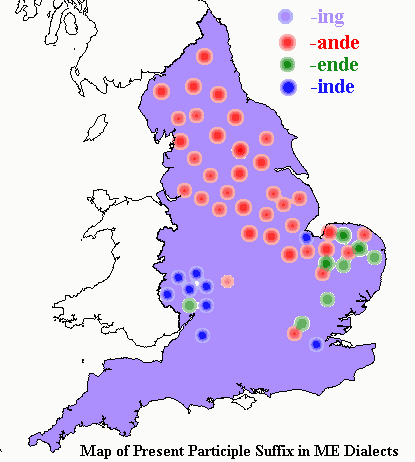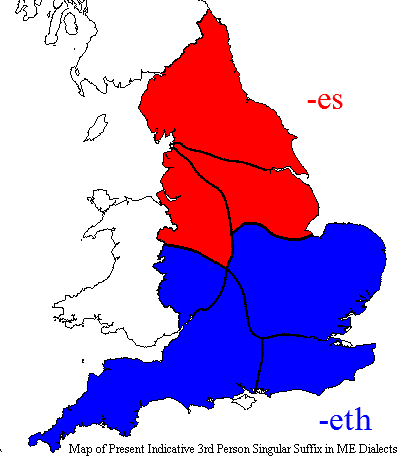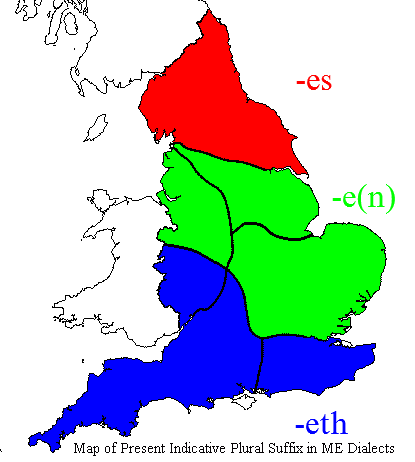2011-11-24 Thu
■ #941. 中英語の言語変化はなぜ北から南へ伝播したのか [geography][me][wave_theory][geolinguistics][3sp]
古英語後期から中英語初期をへて中英語後期に至るまで,多くの言語変化がイングランドの北から南,より正確には北東から南西へと伝播していった.人称代名詞の she (she を参照)や they ([2011-04-10-1]を参照)の普及,3単現の -s の拡大,複数形の -s (Hotta の研究を参照)の伸長,古ノルド語からの多くの語彙の借用,そして英語史上最大の変化と言えるかもしれない屈折の水平化や文法性の消失も,北部・東部の方言が牽引した.現代のイギリス標準英語にかつての北部や東部の方言の痕跡が色濃いのは,中英語期に見られたこの「方向性」ゆえである.
しかし,なぜ北から南という方向なのか,伝播の原動力は何なのかという問題は,謎である.言語地理学 (linguistic geography or geolinguistics) では,言語変化は波紋状に伝播するという the wave theory が古くから唱えられている.それによれば,イングランドという池の北部に大きな石が投げ込まれ,その余波が何重もの波紋を描いて徐々に周囲へ,特に南部へと広がって行った,と説明できる.実際に,上記の諸変化は,概ね波状理論の示すとおりに伝播していったことが知られている(少なくとも,複数形の -s の伝播については拙著で確認した).だが,投げ込まれた石がなぜこれほどまでにエネルギーをもったのかが不明である.社会言語学では,通常,そのようなエネルギーは社会的に影響力のある地域(典型的には都市部)に発し,そこを起点として余波が地方へと伝播してゆくものと考えられており,南部のロンドンから北部の田舎へという方向ならば理解できるのだが,事実は逆である.なぜなのか.
この問題については拙著 (175) でも言及しているが,そこで引用した Thomason and Kaufman (274) からの一節を紹介しよう.
Until about 1225 innovations starting in the South were spreading northward (e.g., /aː/ > /oə/, 'ɣ' > w/y), after 1250 practically all innovations in English were starting in the North and spreading southward (e.g. lengthening of short stressed vowel in open syllable, dropping of final unstressed schwa, degemination, spread of third person singular present tense -es at the expense of -eth). No explanation (except that York, England's second city, is located in Deira) can as yet be offered for why the North should have been so influential on the Midlands and South from 1250 to 1400, since it was much poorer than the rest of England, and was constantly being raided by the Scots, with whom the Northerners (ruefully, one supposes) shared a dialect.
他所で,Thomason and Kaufman (289) は,Sawyer (174--75) を参照しながら次のようにも述べている.
. . . there was a great growth of quite profitable sheep-farming at the hands of Norse-origin or even Norse-speaking entrepreneurs in the eleventh century in the Lincolnshire Wolds (which lie in Lindsey, the major town being Louth) and in the Yorkshire Wolds (which lie in the East Riding of Yorkshire part of Deira, the major town being Bridlington), which lie right across the Humber from each other . . . .
こうした議論を受けながら,私は拙著 (175) において,しどろもどろに次のような意見を述べるにとどまった.
I cannot offer a strong alternative, but it is possible that as carriers of Norsified English in the North and East passed innovative linguistic features to neighbouring areas through person-to-person communication, the receiving areas willingly picked up the Norsified features as "faddish." For the time being, however, I would like to leave this question open.
この問題について最近 O'Neil (266) に見つけた別の意見を紹介しておこう.
Now why the northern Middle English system became that of all England is not at all clear. . . . After the return to English as the language of the English realm there may have been a (mistaken, note) feeling that it was in the north that real English resided, thus leading to it becoming the accepted model toward which the rest of England moved. This is an explanation of sorts, albeit not a very satisfactory one (1).
引用最後の (1) は脚注への参照で,その脚注には以下のようにある.
(1) It is, however, difficult to reconcile this explanation --- such as it is --- with the general London antipathy toward the northern dialects of Middle English. (266)
謎は深まる一方である.
・ Hotta, Ryuichi. The Development of the Nominal Plural Forms in Early Middle English. Hituzi Linguistics in English 10. Tokyo: Hituzi Syobo, 2009.
・ Thomason, Sarah Grey and Terrence Kaufman. Language Contact, Creolization, and Genetic Linguistics. Berkeley: U of California P, 1988.
・ Sawyer, P. H. The Age of the Vikings. 2nd ed. London: Edward Arnold, 1971.
・ O'Neil, Wayne. "The Evolution of the Germanic Inflectional Systems: A Study in the Causes of Language Change." Orbis 27 (1980): 248--86.
2011-06-26 Sun
■ #790. 中英語方言における動詞屈折語尾の分布 [me_dialect][inflection][suffix][participle][lalme][map][3pp][3sp]
中英語の方言差を特徴づける形態素は数多くあるが,顕著なものの1つに現在分詞語尾がある.現代英語の -ing に相当する語尾だが,大きく分けて -ing, -ande, -ende, -inde の4種類があり,それぞれ特徴的な分布を示す.以下は,LALME の Dot Map 345--51 を参照して,およその分布を再現したものである.

-ing はすでに England の全域に分布しており,方言特徴と呼ぶのはふさわしくないかもしれないが,その異形態として現われる -nd(e) 形の母音部分の差が方言をよく弁別する.-ande の分布は Northern から East Midlands にかけての地域(かつての Danelaw )に一致する.-ende は East Midlands ,-inde は South-West Midlands に集中する.ロンドン付近で複数の異形態が観察されるのは,その地がまさに諸方言の境であることを示している.
現在分詞語尾の他には,直説法3人称単数現在語尾と直説法複数現在語尾が,方言特徴をよく表わすものとして知られている.この2項目の分布は残念ながら直接 LALME の Dot Map には与えられていない.いきおい図式的ではあるが,Burrow and Turville-Petre (31--32) の記述を参考に,地図化してみた.


この3つの動詞屈折語尾に注目するだけでも,ある程度,中英語の方言の絞り込みができるだろう.
・ McIntosh, Angus, M. L. Samuels, and M. Benskin. A Linguistic Atlas of Late Mediaeval English. 4 vols. Aberdeen: Aberdeen UP, 1986.
・ Burrow, J. A. and Thorlac Turville-Petre, eds. A Book of Middle English. 3rd ed. Malden, MA: Blackwell, 2005.
Powered by WinChalow1.0rc4 based on chalow